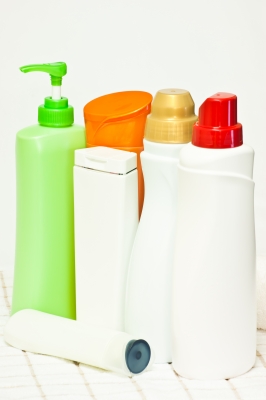If It’s On Your Skin, It Could Be In Your Bloodstream
The potential for absorbing harmful substances through the skin is enormous. When we lather up in the shower, shampoo, apply skin creams and make-up, we’re getting a dose of whatever is rubbed onto our skin. Almost anything with lipophilic (which means oily or fatty) or fat soluble (dissolves in fat) characteristics are likely to be absorbed through the skin.
Not everything that goes through the skin is potentially toxic, but unfortunately much of it is. The biggest source of contamination through the skin is body care products, which contain thousands of untested and unregulated chemicals. Well, they are tested, but only to find out if they’re going to make you break out in a rash.
There are virtually no requirements for toxicity or carcinogen warnings on labels, and all sorts of loopholes to avoid honest labeling. A good example is the use of the word “fragrance” on an ingredients label. Just about anything that could possibly be construed to be included in a fragrance can be encompassed in that word, including phthalates, which are petrochemical plastics that are known to cause cancer and reproductive abnormalities. The other catchall, used most commonly in pesticides, is “inert ingredients,” which can encompass a veritable stew of harmful chemicals.
Another good example of a hidden contaminant is Quaternium-15, a preservative found in many body care products-including baby shampoos-that releases formaldehyde.
Products with Ingredients Than Can Enter The Bloodstream Through The Skin:
- Cosmetics – makeup, lipstick, etc
- Creams, lotions, gels, moisturizers, wipes
- Soap, shower gel, bubble bath
- Shaving cream, aftershave
- Hair products – shampoos, conditioners, gels and dyes
- Powders
- Deodorants
- Toothpaste
- Wipes
- Fragrances (perfumes, colognes, anything scented)
- Nail Polish and nail polish remover
- Laundry detergent (especially scented)
- Fabric Softeners
- Dry cleaned clothing
- Polyester and permanent press clothing
- Household cleaners, especially sprays
- Polishes and waxes
- Paint
- Pesticides, including insect repellents and pet products
- Glues
- Paper
- Ink, toner
- Gardening products
- Lubricants – motor oil, WD-40
- Chlorinated water
The list of chemicals in the above products that can be toxic is almost endless, so the trick is to find the cleanest products you can, especially when it comes to personal care products. The words “natural” or “organic” on a label are almost meaningless-you can have one organic ingredient out of 20 and call a product organic and “natural” means nothing when it involves shopping. And just because you buy something in a health food store is no guarantee that it’s safe or free from harmful chemicals.
How to Find Healthy Skin Products
A good source of information on ingredients in personal care products has been compiled on the Environmental Working Group (EWG) website. They have a section called Skin Deep that rates products based on how many potentially toxic or carcinogenic chemicals they contain. It’s sad but true that all those chemicals do make body care products feel better, spread better and preserve better, so there is a trade-off in using cleaner products. One of the cleaner brands for hair, skin and body care is Aubrey Organics.
An Ounce of Prevention
For cleaning products, paints, gardening etc, wear gloves, work in a well-ventilated area and find the least toxic product for accomplishing the task. If your water is chlorinated, get a shower head filter-most of them are inexpensive and easy to install. For pregnant or nursing
mothers, painting, finishing furniture, using pesticides or acetones (think nail polish) should be out of the question. In this case it isn’t just about getting these substances on the skin, it’s also about breathing them.
The Goal is to Minimize Exposure
Unless you’re a fetus or an infant, your exposure to any one of these products at any one time (assuming normal use) is unlikely to be toxic; it’s the daily exposure to numerous sources that creates toxicity over time. In 2003 the Centers for Disease Control (CDC) released the results of research that tested for 116 contaminants in the blood and urine of thousands of people, representing a wide range of geography and lifestyle. The majority of people tested had detectable levels of contaminants. Obviously you can’t entirely avoid everything that you might breathe or get on your skin that might be toxic-that would be way too stressful! The goal is to be aware and minimize your exposure.
And by the way, the word “organic” is meaningful for food products, and children who eat organically grown fruits and vegetables have one-sixth the levels of organophosphate pesticides in their urine compared to children who don’t eat organic fruits and vegetables.
Resources:
Centers for Disease Control and Prevention, “Second National Report on Human Exposure to Environmental Chemicals,” Jan 31, 2003, http://www.cdc.gov/exposurereport/.
Curl, C.L. et al, “Organophosphorus pesticide exposure of urban and suburban preschool children with organic and conventional diets,”
Environmental Health Perspectives, 111(March):377-382.
Environmental Working Group, http://www.ewg.org
Mowad, Christen M, “Allergens of New and Emerging Significance,” Dermatol Nurs 2006;18(6):545-548.
The Author:
Reprinted with permission of the Virginia Hopkins Health Watch.
The Virginia Hopkins Health Watch is an e-mail newsletter about natural hormones, nutrition news, alternatives to prescription drugs, and much more! On her website you’ll also find the Natural Hormone Education & Research Library. Find out more at http://www.virginiahopkinstestkits.com
Photo. Photoexplorer
